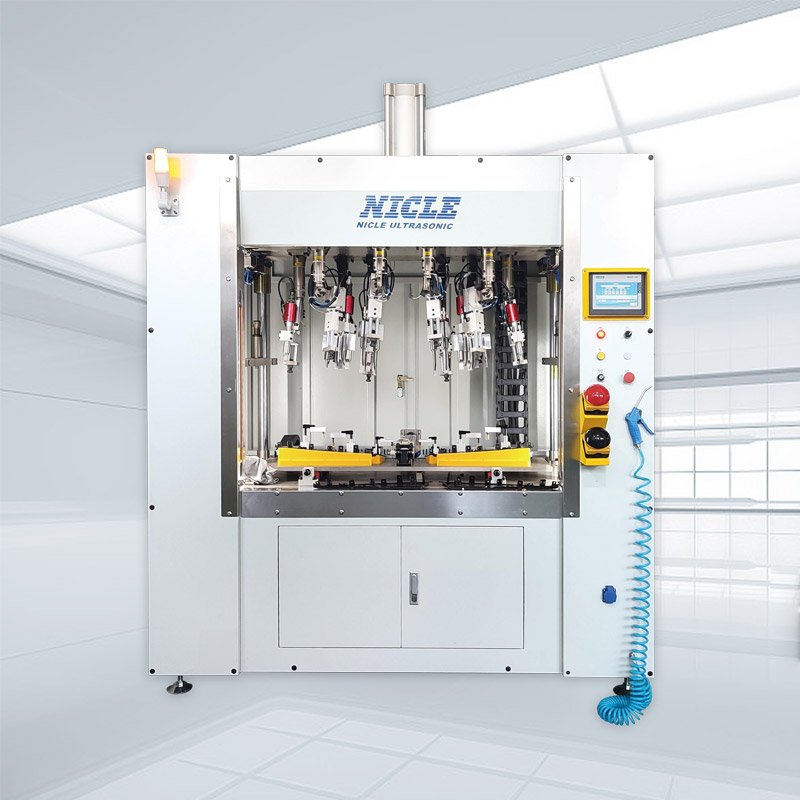In the medical and scientific research fields, ABS reagent cylinders are essential for storing and transporting various reagents. The quality of their welding directly impacts the stability of the reagents and the accuracy of experimental results. Ultrasonic welding machines, with their unique advantages, have become a preferred method for welding ABS reagent cylinders. However, challenges related to material properties, welding precision, and quality control often arise in practice. This article explores these challenges and offers practical solutions to optimize the welding process.

Why ABS Material is Ideal for Reagent Cylinders
ABS (acrylonitrile-butadiene-styrene copolymer) is widely used in manufacturing reagent cylinders due to its excellent mechanical properties, including high strength, chemical resistance, and ease of processing. These cylinders are designed to hold chemical reagents, biological samples, and other sensitive materials, requiring exceptional sealing, structural integrity, and chemical stability.
Traditional welding methods often fall short when it comes to meeting the stringent requirements of ABS reagent cylinders. Issues such as insufficient weld strength and potential reagent contamination are common. Ultrasonic welding, on the other hand, uses high-frequency vibrations to generate heat for welding, offering benefits such as rapid welding speed, airtight seals, and contamination-free results. This makes it a game-changer for ABS reagent cylinder manufacturing.
Applications of Ultrasonic Welding in ABS Reagent Cylinders
Ultrasonic welding is particularly effective in the following scenarios:
- Blood Test Reagent Cylinders
In clinical blood testing, reagent cylinders must securely contain blood samples and testing reagents. Ultrasonic welding ensures a tight seal between the cylinder body and lid, preventing leaks during transport and testing, thereby guaranteeing accurate results.
- Immunoassay Reagent Cylinders
These cylinders store immunoassay reagents, which demand high sealing and chemical stability. Ultrasonic welding ensures that all components are securely bonded, protecting the reagents from external contamination and maintaining their reliability over time.
- Chemical Analysis Reagent Cylinders
Chemical analysis experiments require precise reagent storage. Ultrasonic welding achieves accurate bonding between the cylinder body, base, and lid, ensuring both airtight seals and dimensional precision for seamless integration with laboratory equipment.
- Biological Experiment Reagent Cylinders
In biological experiments involving cell cultures or DNA extraction, sterility is paramount. Ultrasonic welding maintains a contamination-free process, ensuring the integrity of biological samples and reagents.
Challenges in Ultrasonic Welding of ABS Reagent Cylinders
Despite its advantages, ultrasonic welding of ABS reagent cylinders presents several challenges:
- Thermal Sensitivity of ABS Material
ABS is prone to degradation and deformation at high temperatures. Improper control of welding parameters can lead to overheating, material degradation, or warping, compromising the cylinder's sealing and structural strength.
- Dimensional Accuracy
The precision of reagent cylinder dimensions is critical for compatibility with laboratory equipment and accurate reagent handling. Thermal expansion and stress changes during welding can cause deviations, leading to issues such as misalignment with pipettes or other instruments.
- Sealing Precision
Even minor inconsistencies in the weld, such as uneven seams or tiny gaps, can result in reagent leakage or contamination, rendering the cylinder unusable.
Solutions to Overcome Welding Challenges
To address these challenges, manufacturers can adopt the following strategies:
- Optimization of Welding Parameters
Conduct extensive experiments and data analysis to establish a database of welding parameters tailored to different ABS material batches. During production, retrieve and fine-tune these parameters based on the specific material batch to ensure optimal results.
- High-Precision Mold Design
Utilize advanced mold design software and manufacturing techniques to create molds that account for ABS material's thermal expansion and contraction. Incorporate appropriate shrinkage allowances to maintain dimensional accuracy post-welding.
- Advanced Process Control Systems
Implement real-time monitoring systems equipped with sensors to track pressure, displacement, and ultrasonic energy during welding. Use closed-loop control algorithms to automatically adjust parameters, ensuring consistent and stable welding outcomes.
Conclusion
Ultrasonic welding has proven to be a valuable technology for manufacturing ABS reagent cylinders, despite the challenges posed by material properties and precision requirements. By leveraging optimized welding parameters, high-precision molds, and advanced process control systems, manufacturers can overcome these hurdles and achieve superior welding quality and efficiency.
As the medical and scientific research industries continue to advance, the demand for high-quality reagent cylinders will only grow. Ultrasonic welding technology is poised to play an increasingly vital role in meeting these demands, driving innovation and ensuring the reliability of critical laboratory tools. By embracing these solutions, manufacturers can deliver high-performance ABS reagent cylinders that meet the rigorous standards of modern science and medicine.
If you want custom ultrasonic weld equipment, please contact Dizo Global.






